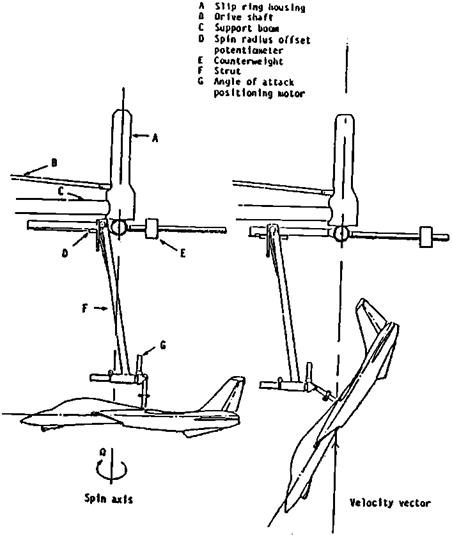Rotary Balances and the Steady Spin
Rotary balances are designed to extract rotary derivatives from wind-tunnel tests. The model is typically held at some fixed angles of attack and sideslip to the relative wind and rotated by an electric motor at a fixed rate (Figure 9.6). Combined aerodynamic, gravity, and inertial forces and moments are measured by a six-component balance internal to the model. The desired aerodynamic forces and moments are obtained by subtracting the other components, as tares. Rotary balance tests in which angles of attack and sideslip remain constant are called “coning tests.” The spinning axis is aligned with the tunnel flow direction for coning tests.
Rotary balance testing actually predates the free-spinning tunnel, with E. F. Relf and T. Lavender’s 1922 and 1925 measurements in Britain. An earlier paper (Relf and Lavender,
|
Figure 9.6 The NASA Langley Research Center’s current spin tunnel rotary balance rig. The electric motor that spins the model is outside the tunnel. At the left, a model in a flat-spinning orientation; a normal spin orientation is at the right. This is believed to be the only rotary balance in current (early 1990s) use at Langley. (From Bihrle and Chambers, AGARD AR 265, 1990) |
1918) described some of the first tests on autorotating wings. Autorotation is wing negative damping in roll, at angles of attack beyond the stall. Autorotation provides a driving or propelling moment in spins.
Until the coming ofthe jet airplane and the oscillatory spin, the chiefuse of rotary balance testing was in finding the steady spin modes of an airplane. That is, would spins be steep, or easily recoverable, or fast and flat, with problematic recoveries? The pioneering rotary balance work of thistype wasdone by P. H. Allwork using the NPL 7-foot wind tunnel in Britain, and Millard Bamber and Charles Zimmerman in the NACA 5-foot vertical wind tunnel.
With simplifying assumptions, the three force equations of the ordinary 6-degree – of-freedom equations of airplane motion reduce to only two equations, which are not simultaneous with the three moment equations. Under steady conditions, angular accelerations drop out. With aerodynamic data from rotary balance coning tests, the remaining three simultaneous moment equations are fairly readily solved for the equilibrium spin.
The groundwork for equilibrium spin analysis was laid in a remarkable 1926 report by Sidney B. Gates and L. W. Bryant. The Gates and Bryant report was far ahead of its time, and quite comprehensive. A modern explanation of the mechanics of the equilibrium spin solution is given in William Bihrle, Jr.’s paper in Sec. 9.1 of AGARD Advisory Report No.265, dated 1990.















